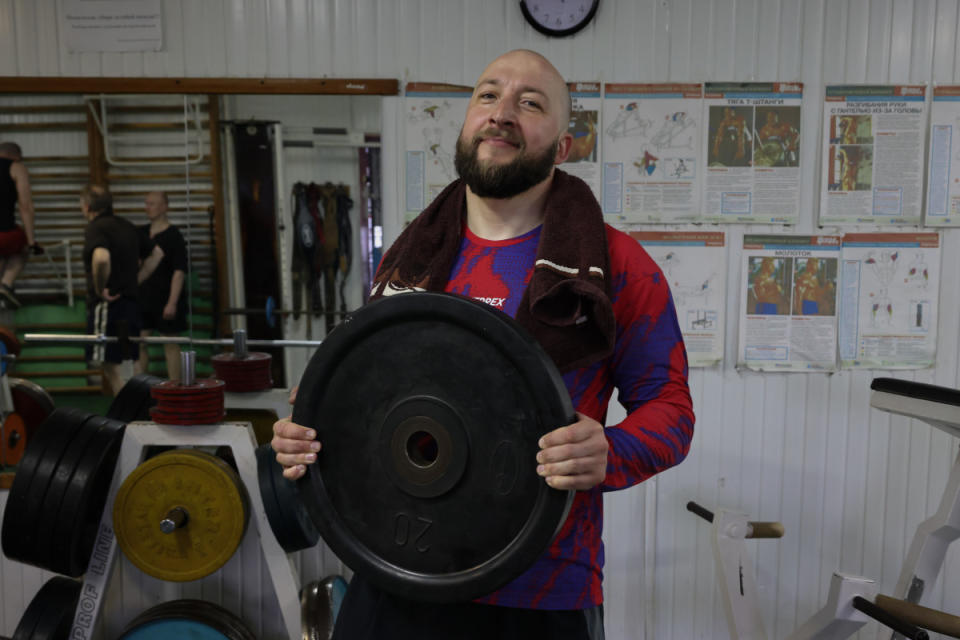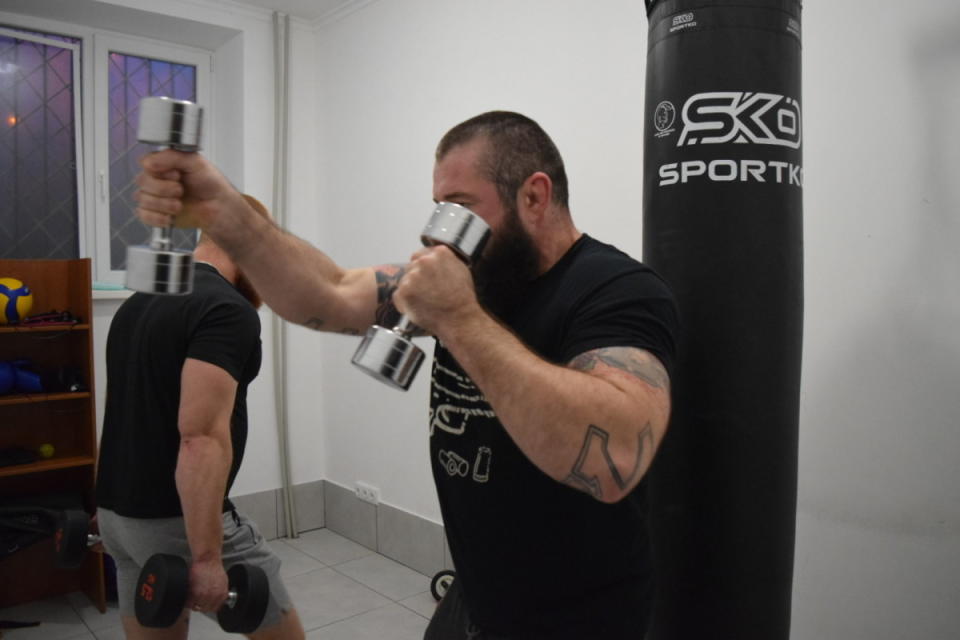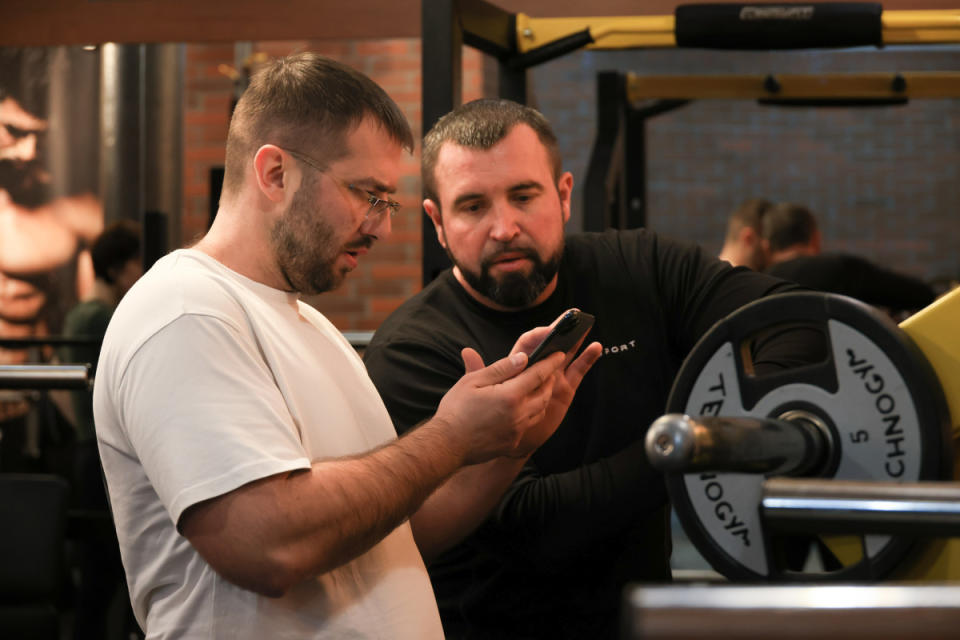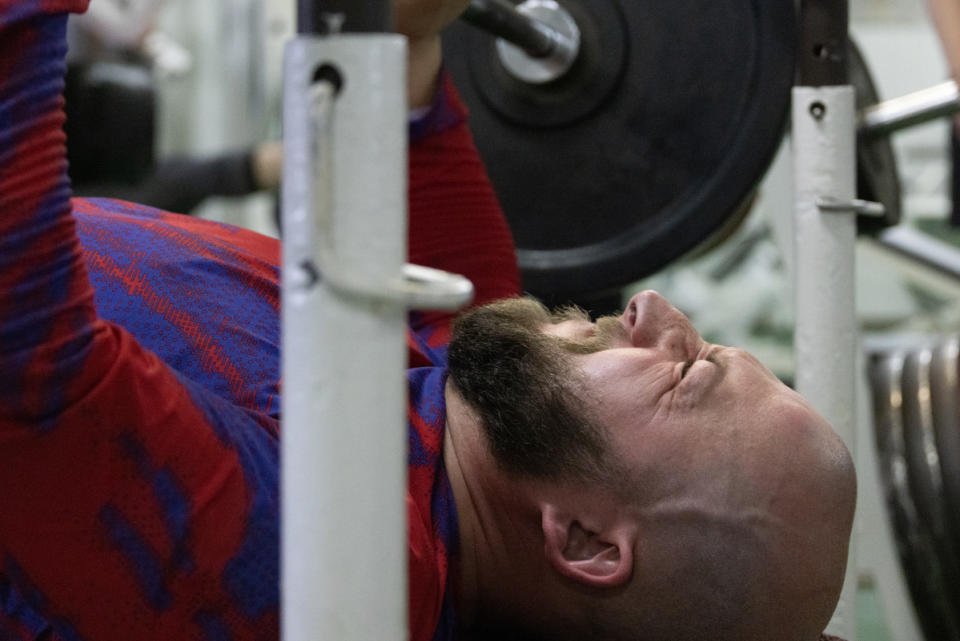For Ukrainian Soldiers, the Gym Is a Relief From the Trenches
- Oops!Something went wrong.Please try again later.
Volodymyr the machine gunner slowly traces a halo around his head and shoulders with a 40-pound plate. He's alone in the small, dimly lit gym, save for pop music playing in the background
As a Ukrainian soldier, he's been near death and watched friends die on the frontlines ever since Russian President Vladimir Putin announced a “special military operation” in Ukraine and launched a full-scale attack on Feb. 22, 2022.
But today, the 39-year-old isn't fighting. He's strengthening his arms and back, targeting the areas of his body that are under constant strain from wearing his bulletproof vest and carrying his equipment. “I need energy to run with weapons, to move constantly,” he says. “The gym gives me this. You become more balanced, calm, and concentrated, both physically and mentally.”
“You do it to be more agile, faster, more enduring, [to] help you survive or destroy as many enemies as possible," Volodymyr says.

Nikoletta Stoyanova
Volodymyr is stationed in Kramatorsk while his three-year-old son is back in Kyiv, achieving milestones without his father by his side. The soldier worries everyday that he might miss the next one and terrified that a stray mortar or bullet might mean he never sees another.
The stress weighs on him constantly. But here, surrounded by dumbbells, barbells, and cardio machines, Volodymyr is able to escape from his fears: "It feels as if you are returning to a civilized life that your body understands."
Soldiers experience a wealth of benefits from exercise, like improved sleep, decreased depression symptoms, and a reduced risk of post-traumatic stress disorder (PTSD), according to the CDC. Exercise can also treat PTSD symptoms, according to a report by the Association of Military Surgeons of the United States, and it's been shown to have a greater effect on depression than what is typically expected from antidepressants. The report also found that exercise can “reduce an individual’s perception of stress, provide healthy coping mechanisms, and improve overall mental health.”
"The gym is very mentally and psychologically reassuring," says Volodymyr. "You work on yourself. You're very focused on your physical sensations. It calms you down a bit.”
In a gym down the street from Volodymyr's, two soldiers in black shirts and gray bottoms zip through a flurry of exercises in a small side room, no bigger than a walk-in closet. One of them, Orest, springs through eight burpees before transitioning to 18 seconds of chest presses with a 33-pound plate. He leaps into lunges with 27-pound dumbbells in each hand, then quickly drops to 20 seconds of pushups. He contorts, presses, and pushes his body in a frantic but controlled pace over nearly two minutes, only stopping for five seconds to reset between rounds.

Anna Conkling
Orest, 37, who has been a soldier since 2014 but declined to share more details, isn’t focused on sculpting a toned gym body. His daily uniform consists of a 35-pound bulletproof vest and up to an additional 132 pounds of machine guns, ammunition, backpacks, and drinking water. His unit aims to hit a gym every day when it's not on the frontlines, performing cardio and strength training.
Another soldier, 27-year-old Mikhal from Kamatorsk, prepares to leave the gym after completing his workout. Initially a policeman, he joined the military as part of its intelligence division after Russia launched its invasion in 2022. When he’s not carrying out reconnaissance missions, he’s exercising.
“When you go on combat missions, you put on such a large amount of equipment in which you need to spend sometimes even more than 12 hours,” he says. “This is a big load on the back and torso. Here’s a bulletproof vest, a helmet, and a load on the neck. You need to keep your body in sports shape.”
Even in the trenches at a zero-position line, Mikhal has seen soldiers work out with free weights when they have a moment’s rest. Volodymyr has even used hefty tree logs to squat and bench press when he doesn’t have gym access.
“We’re very nervous. We need to look for some moments when we can replenish [energy],” Mikhal says. “If your social circle is athletes, you have a close-knit sports family [that] always sticks together, regardless of the division.”
While stationed in Kramatorsk, Volodymyr calls home as much as he can, recording videos of himself reading fairy tales to help his son fall asleep.
The town even provides a sense of normalcy. “You can go out to eat and get coffee. It’s like Las Vegas compared to other frontline cities. They even have electricity.”
Kramatorsk lies in the eastern Donbas region of Ukraine, which first experienced Russian aggression in February 2014, when Russia occupied the Donetsk and Luhansk regions and annexed the Crimean peninsula. That April, pro-Russian separatists with the Donetsk People’s Republic took control of Kramatorsk, and it remained under their control for three months until the Ukrainian government launched a counteroffensive that reclaimed control of the city in July of that year. Now, the city is once again in turmoil. Yet after two years of war, even with electricity and restaurants, it's littered with destroyed homes and buildings, the concrete bones at odds with the still-standing buildings around them.
Because it’s near the frontlines, it’s a struggle for businesses in Kramatorsk to remain open. “Not a single insurance company will insure anything here,” says Yuri Petrenko, who owns the gym where Orest and Mikhal work out. “What’s the point? War is not an insured case.”
Patrenko opened his gym in October 2023, nearly 10 years after the 2014 attack on the city forced him and his family to flee to Dnipro, four hours away. Petrenko, now 36, dreamed of owning a gym since childhood, the culmination of a lifelong love for athletics. During exile from his home city, Petrenko visited gyms, filmed videos of what they looked like, and took stock of their equipment. He decided to build his gym in Kramatorsk to serve the people who’ve endured a decade of Russian aggression.

Nikoletta Stoyanova
Petrenko anticipated that his gym would be frequented by the Kramatorsk civilians who’d remained, he tells me in an empty women’s locker room. “People see what kind of equipment, what kind of repairs, what kind of approach we have here. Sports nutrition, service. Special food. Everyone likes everything here.”
Complimentary coffee and tea welcome patrons entering Petrenko's gym. The smaller of the two workout rooms hosts treadmills, stationary bikes, and other cardio machines, while the larger workout room is split in half—machines on one side, free weights on the other—all adorned with brand new equipment from Techno, an official supplier for the Olympic games.
Upon opening day, soldiers flooded in on short breaks from war. They now make up at least half of his customer base. The monthly membership is $15, but only around 100 people have signed up. Soldiers tend to opt for the $2 daily rate because could be relocated at any time. Petrenko says he earns just enough to get by. The gym only accumulates around $2,000 per month, which is used to pay rent, electricity, water, and employee salaries.
Even if it's not the best business model, Petrenko welcomes the soldiers with open arms. But he’s also aware that his business, his dream, now has a target on its back. The sound of air raid sirens rings inside the gym frequently, as explosions echo in the distance.
Volodymyr is surviving. He recently spent a short break in Kyiv with his son. He was filled with the joy, he says, that only comes at the end of longing. His son clung to him, worried that even after leaving for a simple trip to the grocery store, that his father might not return.

Nikoletta Stoyanova
“When I went to the army, he was two years old and spoke only two words: mom and dad,” Volodymyr says. “Now, he’s telling me about the planets of the solar system. His favorite is Saturn.”
If he returns to Kramatorsk, the gyms might cease to exist. Places where targets hang out, like a former pizzeria that often hosted journalists, aid workers, and civilians, are leveled by Russian bombings.
“I will die with arms in my hands, defending my way of life, my Ukrainian-ness, [my] country, my home,” he sayz. He only hopes that his son can look at his courageous acts and learn how to be indestructible, resilient—skills honed on the battlefield as well as under the fluorescent lights in gyms across Ukraine.
Related: Hit by a Russian Mortar and Trapped Under Tank Fire, One Soldier's Improbable Rescue

